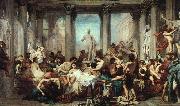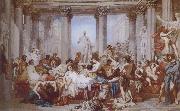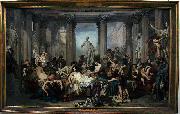Wholesale Oil Painting No Minimum |
|||||||||||
|
|
|||||||||||

|
|||||||||||
|
|
|
||||||||
Thomas Couture1815-1879 French Thomas Couture Location French painter and teacher. A student of Antoine-Jean Gros in 1830-38 and Paul Delaroche in 1838-9, he demonstrated precocious ability in drawing and was expected to win the Prix de Rome. He tried at least six times between 1834 and 1839, but achieved only second prize in 1837 (entry untraced). Disgusted with the politics of the academic system, Couture withdrew and took an independent path. He later attacked the stultified curriculum of the Ecole des Beaux-Arts and discouraged his own students from entering this institution. He first attained public notoriety at the Paris Salon with Young Venetians after an Orgy (1840; Montrouge, priv. col., see Boime, p. 85), the Prodigal Son (1841; Le Havre, Mus. B.-A.) and the Love of Gold (1844; Toulouse, Mus. Augustins). These early canvases are treated in a moralizing and anecdotal mode; the forms and compositional structures, like the debauched and corrupt protagonists, are sluggish and dull. Yet what made his work seem fresh to the Salon audience was his use of bright colour and surface texture derived from such painters as Alexandre-Gabriel Decamps and Eugene Delacroix, while his literary bent and methodical drawing demonstrated his mastery of academic tradition. The critics Thophile Gautier and Paul Mantz (1821-95) proclaimed him as the leader of a new school that mediated between the old and the new, and looked to him for a revitalization of Salon painting. The air of compromise his works projected made him appear a cultural representative of the juste milieu policies of Louis-Philippe. |
||||||||
|
|
||||||||
The Romans of the Decadence
The Romans of the Decadence Painting ID:: 561 |
1847
Musee d'Orsay, Paris 1847 Musee d'Orsay, Paris |
|||||||
|
|
||||||||
Thomas Couture1815-1879 French Thomas Couture Location French painter and teacher. A student of Antoine-Jean Gros in 1830-38 and Paul Delaroche in 1838-9, he demonstrated precocious ability in drawing and was expected to win the Prix de Rome. He tried at least six times between 1834 and 1839, but achieved only second prize in 1837 (entry untraced). Disgusted with the politics of the academic system, Couture withdrew and took an independent path. He later attacked the stultified curriculum of the Ecole des Beaux-Arts and discouraged his own students from entering this institution. He first attained public notoriety at the Paris Salon with Young Venetians after an Orgy (1840; Montrouge, priv. col., see Boime, p. 85), the Prodigal Son (1841; Le Havre, Mus. B.-A.) and the Love of Gold (1844; Toulouse, Mus. Augustins). These early canvases are treated in a moralizing and anecdotal mode; the forms and compositional structures, like the debauched and corrupt protagonists, are sluggish and dull. Yet what made his work seem fresh to the Salon audience was his use of bright colour and surface texture derived from such painters as Alexandre-Gabriel Decamps and Eugene Delacroix, while his literary bent and methodical drawing demonstrated his mastery of academic tradition. The critics Thophile Gautier and Paul Mantz (1821-95) proclaimed him as the leader of a new school that mediated between the old and the new, and looked to him for a revitalization of Salon painting. The air of compromise his works projected made him appear a cultural representative of the juste milieu policies of Louis-Philippe. |
||||||||
|
|
||||||||
|
|
The Romans of the Decadence
The Romans of the Decadence Painting ID:: 40693 |
mk156
1847
Oil on canvas
466x775cm
mk156 1847 Oil on canvas 466x775cm |
||||||
|
|
||||||||
Thomas Couture1815-1879 French Thomas Couture Location French painter and teacher. A student of Antoine-Jean Gros in 1830-38 and Paul Delaroche in 1838-9, he demonstrated precocious ability in drawing and was expected to win the Prix de Rome. He tried at least six times between 1834 and 1839, but achieved only second prize in 1837 (entry untraced). Disgusted with the politics of the academic system, Couture withdrew and took an independent path. He later attacked the stultified curriculum of the Ecole des Beaux-Arts and discouraged his own students from entering this institution. He first attained public notoriety at the Paris Salon with Young Venetians after an Orgy (1840; Montrouge, priv. col., see Boime, p. 85), the Prodigal Son (1841; Le Havre, Mus. B.-A.) and the Love of Gold (1844; Toulouse, Mus. Augustins). These early canvases are treated in a moralizing and anecdotal mode; the forms and compositional structures, like the debauched and corrupt protagonists, are sluggish and dull. Yet what made his work seem fresh to the Salon audience was his use of bright colour and surface texture derived from such painters as Alexandre-Gabriel Decamps and Eugene Delacroix, while his literary bent and methodical drawing demonstrated his mastery of academic tradition. The critics Thophile Gautier and Paul Mantz (1821-95) proclaimed him as the leader of a new school that mediated between the old and the new, and looked to him for a revitalization of Salon painting. The air of compromise his works projected made him appear a cultural representative of the juste milieu policies of Louis-Philippe. |
||||||||
|
|
||||||||
|
|
The Romans of the Decadence
The Romans of the Decadence Painting ID:: 83401 |
1847(1847)
Medium Oil on canvas
Dimensions 466 x 773 cm (183.5 x 304.3 in)
cyf 1847(1847) Medium Oil on canvas Dimensions 466 x 773 cm (183.5 x 304.3 in) cyf |
||||||
|
|
||||||||
Thomas Couture1815-1879 French Thomas Couture Location French painter and teacher. A student of Antoine-Jean Gros in 1830-38 and Paul Delaroche in 1838-9, he demonstrated precocious ability in drawing and was expected to win the Prix de Rome. He tried at least six times between 1834 and 1839, but achieved only second prize in 1837 (entry untraced). Disgusted with the politics of the academic system, Couture withdrew and took an independent path. He later attacked the stultified curriculum of the Ecole des Beaux-Arts and discouraged his own students from entering this institution. He first attained public notoriety at the Paris Salon with Young Venetians after an Orgy (1840; Montrouge, priv. col., see Boime, p. 85), the Prodigal Son (1841; Le Havre, Mus. B.-A.) and the Love of Gold (1844; Toulouse, Mus. Augustins). These early canvases are treated in a moralizing and anecdotal mode; the forms and compositional structures, like the debauched and corrupt protagonists, are sluggish and dull. Yet what made his work seem fresh to the Salon audience was his use of bright colour and surface texture derived from such painters as Alexandre-Gabriel Decamps and Eugene Delacroix, while his literary bent and methodical drawing demonstrated his mastery of academic tradition. The critics Thophile Gautier and Paul Mantz (1821-95) proclaimed him as the leader of a new school that mediated between the old and the new, and looked to him for a revitalization of Salon painting. The air of compromise his works projected made him appear a cultural representative of the juste milieu policies of Louis-Philippe. |
||||||||
|
|
||||||||
|
|
The Romans of the Decadence
The Romans of the Decadence Painting ID:: 85790 |
1847(1847)
Medium Oil on canvas
Dimensions 466 x 773 cm (183.5 x 304.3 in)
cyf 1847(1847) Medium Oil on canvas Dimensions 466 x 773 cm (183.5 x 304.3 in) cyf |
||||||
|
|
||||||||
|
Thomas Couture 1815-1879 French Thomas Couture Location French painter and teacher. A student of Antoine-Jean Gros in 1830-38 and Paul Delaroche in 1838-9, he demonstrated precocious ability in drawing and was expected to win the Prix de Rome. He tried at least six times between 1834 and 1839, but achieved only second prize in 1837 (entry untraced). Disgusted with the politics of the academic system, Couture withdrew and took an independent path. He later attacked the stultified curriculum of the Ecole des Beaux-Arts and discouraged his own students from entering this institution. He first attained public notoriety at the Paris Salon with Young Venetians after an Orgy (1840; Montrouge, priv. col., see Boime, p. 85), the Prodigal Son (1841; Le Havre, Mus. B.-A.) and the Love of Gold (1844; Toulouse, Mus. Augustins). These early canvases are treated in a moralizing and anecdotal mode; the forms and compositional structures, like the debauched and corrupt protagonists, are sluggish and dull. Yet what made his work seem fresh to the Salon audience was his use of bright colour and surface texture derived from such painters as Alexandre-Gabriel Decamps and Eugene Delacroix, while his literary bent and methodical drawing demonstrated his mastery of academic tradition. The critics Thophile Gautier and Paul Mantz (1821-95) proclaimed him as the leader of a new school that mediated between the old and the new, and looked to him for a revitalization of Salon painting. The air of compromise his works projected made him appear a cultural representative of the juste milieu policies of Louis-Philippe. The Romans of the Decadence 1847(1847) Medium Oil on canvas Dimensions 466 x 773 cm (183.5 x 304.3 in) cyf |
||||||||
|
|
||||||||
|
Prev Next
|
||||||||
|
|
||||||||
|
Related Paintings to Thomas Couture :. |
||||||||
|
|
||||||||
|
CONTACT US |




